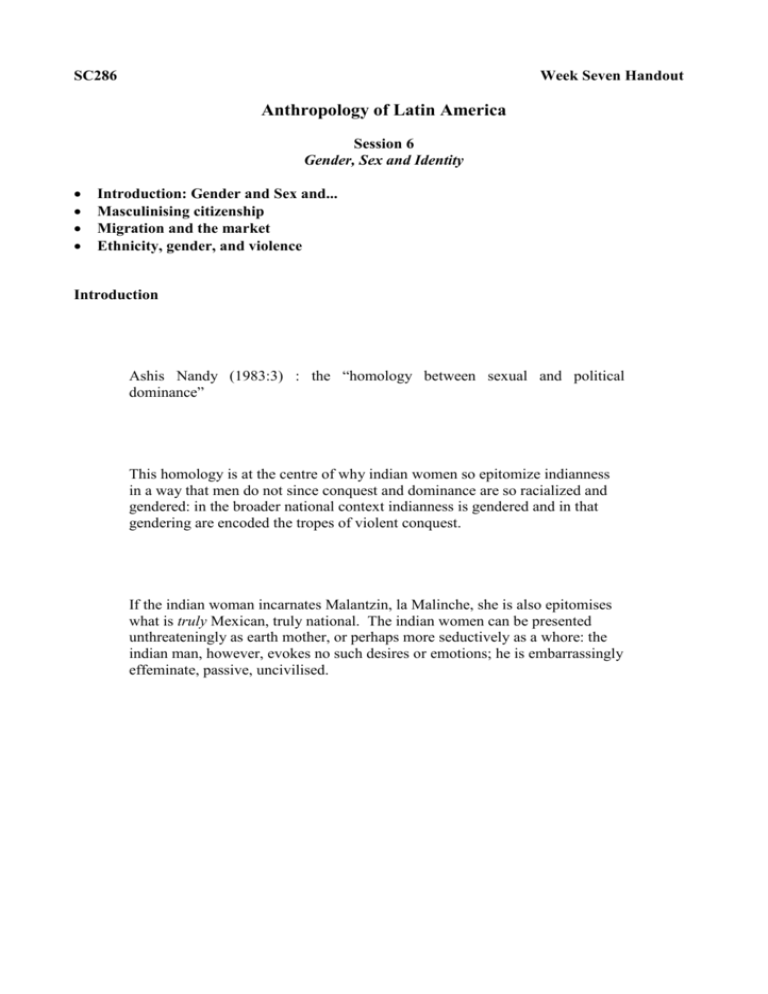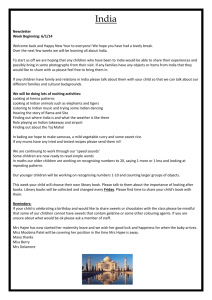
SC286
Week Seven Handout
Anthropology of Latin America
Session 6
Gender, Sex and Identity
Introduction: Gender and Sex and...
Masculinising citizenship
Migration and the market
Ethnicity, gender, and violence
Introduction
Ashis Nandy (1983:3) : the “homology between sexual and political
dominance”
This homology is at the centre of why indian women so epitomize indianness
in a way that men do not since conquest and dominance are so racialized and
gendered: in the broader national context indianness is gendered and in that
gendering are encoded the tropes of violent conquest.
If the indian woman incarnates Malantzin, la Malinche, she is also epitomises
what is truly Mexican, truly national. The indian women can be presented
unthreateningly as earth mother, or perhaps more seductively as a whore: the
indian man, however, evokes no such desires or emotions; he is embarrassingly
effeminate, passive, uncivilised.
Read from Diane Nelson (1999)A Finger in the Wound pp170-1.
When ladino candidates touring the country for votes think they’ve found
“the real Guatemala” on the shores of Lake Atitlán, is is the traditionally costumed,
dutifully worshipping Mayan woman they refer to. Mayan identity, too, leans heavily
on the valiant Mayan woman who maintains her culture, reproduces the next
generation of activists, and pats out tortillas for Mayan men. The Mayan woman
(mujer maya) is an important support for national, ethnic, and class identifications and
for the fashioning of both ladino and Mayan masculinities.
The orthopedics of the law, the labour market, and masculine body image –
“men in traje [traditional dress] are seen as ‘less’ masculine, serious, and competent”
(Hendrickson 1996:162) – make Mayan men “disappear” when they take off their traje.
This process means that traditional clothing, which signifies indigenous identity in
general, has become almost isomorphic witht he Mjayan woman who weaves it and
wears it far more consistently than men. And traje brings with it the weight of
tradition in general, condensing a whole range of affect-laden meanings about
spirituality, community, food, language, children, the nation, and the past onto this
fantasy construct of the mujer maya (a term I use to differentiate this smiling figure
from real life women juggling jobs, children, and “culture”). This is why she is so
important to these different discourses. She joins the modern nation (and Mayan
activists) with the contradictory need to be simultaneously traditional; she magically
produces value with very little investment. And, as Jane Colier suggests, women’s
association with tradition is overdetermined. “Not only do the gender conceptions
associated with modernity identify women with the emotion that is reason’s opposite,
but they also identify women’s homes with leisure and desire...Women are thus cast
both as passive perpetuators of tradition...and as active guardians of the national
culture” (1997:210).
How can Maya women simultaneously epitomise national identity and Maya
identity when the nation is represented as mestizo?
Why are men in traditional dress seen as ‘less’ masculine, serious, and
competent?
What are some of the consequences of such an identification of indianness with
women?
How did Rigoberta Menchu’s fame disrupt such imagery and in what ways did
Guatemalans express their anxiety through humour?
Masculinizing citizenship
2
Read from Canessa (2005) “The Indian within, the Indian without: Citizenship, Race,
and Sex in a Highland Village.” In Canessa (ed) Natives Making Nation:
Gender, Indigeneity and the State. Tucson: University of Arizona Press.
One area of life which is affected, as men become citizens in the nation-state, is
their sexuality. One of the key features of army life mentioned by many Pocobayeños
is the regular visits to prostitutes. Every garrison has its prostitutes which are easily
available and they are apparently a standard feature of army life. It is not only during
their twelve months of army service that Pocobayeños purchase sex. Most spend
extended periods in the gold mines and it is quite common for men to spend several
years in such work before returning to their community to get married. The work is
hard, hot, wet and dangerous and they relax in bars, cinemas and with prostitutes. A
visit to a prostitute costs ‘one gram of gold, for a “quickie”, five to spend the night’.
As one friend put it, ‘They take a lot of gold. “Bring gold!” they say and a little later
we just give it to them.’ 9
Where military service allows Pocabayeños to travel and see their country in its
variety and lay claim to his citizenship, prostitution serves a similar function. One
friend beamed proudly as he told me he had slept with white (rinka), black (nigra) and
indian (chulita) women ‘all the women of Bolivia.’ His clear sense of accomplishment
at having spanned sexually the three most recognisable racial groups in Bolivia is
significant in the context of Bolivia as a mixed nation.
This mixing occurred through sexual relations hinted at in the cover of the
textbook mentioned above. Although in Bolivia the African contribution is rather
more muted, it shares a discourse with many other Latin American countries of being
a product of the mix of European, African and indigenous peoples (e.g. Placido 1999).
Historically in Bolivia and elsewhere in Latin America the social advance that
mestizaje implies has been seen in terms of white men having sex with non-white
women (e.g. Wright 1990, Freyre 1946). Indeed the degenerative (and often putatively
predatory) sexuality of lower class and darker men has been seen as particularly
problematic in twentieth century Latin American discourse which was concerned with
‘improving’ the race (Stepan 1991:93). My friend’s evident pride in having slept with
this variety of women must be seen in this context, a laying claim to his nation not
only through military service and travel but through sex with racial and ethnic
‘others’, a prerogative more generally seen as belonging to creole males (Condarco
Morales 1983:31) and even a civilizing mission (Stephenson 1999:38). The politics of
citizenship are not only gendered but sexualised; and these kinds of multi-racial
sexual experiences may have a political dimension whether or not the individuals
involved explicitly recognise it.
How can sex be racialised? How can race be sexualised?
Why might the sexuality of lower class and darker men be seen as a problem but
the sexuality of lower class and darker women, much less so?
Why might it have been a ‘civilising mission’ for white men to have sex with
darker-skinned women?
What is the “homology between sexual and political dominance” that Nandy
refers to?
3
Migration and markets
Discuss Marisol de la Cadena’s article ‘Women are more Indian?’ (Reading
assignment)
Francisca, who is now in her sixties, describes the predicament she found
herself in when her husband died:
My husband left me without knowing money. No, my husband just took care of
me here. He was the one who knew how to work for money. (When he died) he
left me here without any money. I don’t know how much things are; I don’t
know (the value of) a peso. Now that my husband is lost my children are
teaching me a little.
Read from Canessa (2005) “The Indian within, the Indian without:
Citizenship, Race, and Sex in a Highland Village.”
On a recent trip to the village of Pocobaya in the highlands of Bolivia I found
myself sitting in a friend’s kitchen whilst she prepared one of my favourite dishes. As
she busied herself preparing the guinea pig and I peeled vegetables we chatted about
my goddaughter, Alicia, who had just left her husband because of his violence. We
commiserated with Alicia and then I asked, ‘Do you fight?’ 2 She nodded matter of
factly and explained yes they did, her husband even beat her up once with the metal
tube she uses to blow on the fire, she said with a laugh. We talked on and I asked her
what kinds of things her husband said when they ‘fought.’ She said he often shouted
in Spanish and said ‘carajo’ (damn!) as well as phrases such as ‘india sucia’ (dirty
indian woman) and ‘maldita india’ (accursed indian woman). I was not surprised, as I
had heard people recount similar things before and Bonifacia simply shrugged when I
asked her why her husband spoke to her in this way.
Pocobaya is an indian village several hours’ walk from the nearest road.
Everyone in the village speaks Aymara; all the women dress in the mode which
currently typifies indian dress in Bolivia and all the residents would certainly be
considered indian, indigenous, Aymaras, campesinos or whatever term outsiders use to
characterise the ethnically distinct peasant communities of the highlands. So why then
would a man from this community bark insults in Spanish to his wife and call her an
‘indian’?
So why would a man from this community bark insults in Spanish to his wife
and call her an ‘indian’?
4






